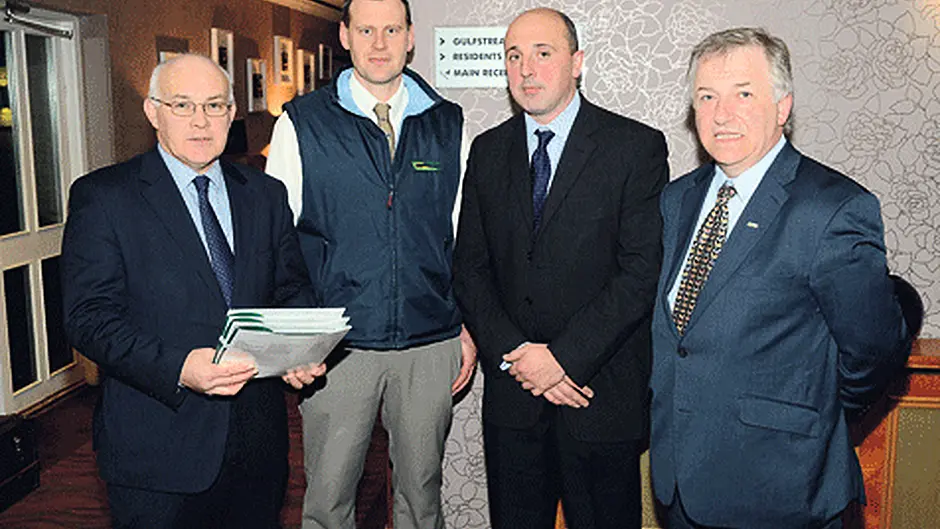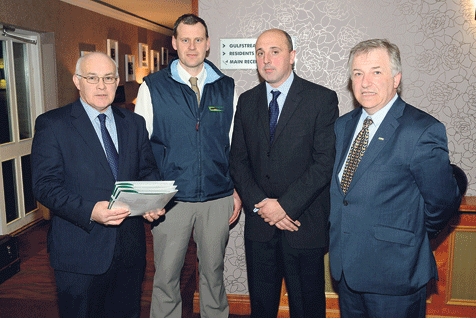Southern Star February 7 2015
BY JOHN SEXTON
MILK production post-2015 and over-quota problems were the main items of discussion at the Teagasc Spring Dairy Seminar held at the Inchydoney Lodge and Spa.
Teagasc had no fewer than ten advisers on the platform and at the various workshops in the second part of the programme. Opening proceedings, Billy Kelleher, regional m,anager for West Cork, stated that with the end of the quota regime, dairy farmers are entering a very exciting time with immense opportunities, but which can also create quite an amount of problems. For that reason, they had a full team present to cover as wide a range as possible of the pitfalls as may arise.
The opening speaker was Padraig French, dairy specialist at Teagasc Moorepark, who dealt with the key factors relating to volatility in the system of production and uncertainty in the marketplace. Farmers, he said, should aim for a compact calving season of six weeks and the aim should be to get them out to grass as soon as possible.
Referring to prices, he said the high price of 2014 cannot be achieved in the future and farmers will have to get used to working on tighter margins. Dealing with the over-quota situation, he stated that there are many options suitable for different farmers.
Brian McCarthy laid much emphasis on the importance of early grazing and, by getting the cows out early, it can greatly reduce the dependence on silage and concentrates. For each extra day a cow is on grass, she will be returning more, provided that the rotation is properly planned; by St Patrick’s Day, 60% of the grazing paddocks should be gone through and the first round should be completed by April 1st.
Stephen Butler dealt with cow management and breeding. For farmers with an over-quota problem, he suggested feeding surplus milk to calves and feeding the cows with a low-protein ration. He said that the farmers should aim to have the calving complete by the end of March and the breeding season should commence during early April. Rene Sayers, a vet attached to the research centre at Moorepark, dealt to a great extent with the welfare of the newborn calf. Calf mortality in Ireland is far too high – 10% as against 3% for Norway.
The newborn calf needs a feed of colostrum within six hours of birth and it must come from the cow’s first milking. She also said that, when cows are fed by night, they tend to calve during the day. As the seminar went into workshop mode, ten advisers took on groups dealing with various topics of the industry: Padraig French, John McNamara, Don Crowley, Eugene Hayes, Seamus O’Dowd, Ann Molone, Stephen Butler, Pat Buckley, Seamus Lordan and Grainne Hurley, with John Maher as MC.
While many farmers feel that the world will be their oyster once quotas are gone, there is a great need for coping with low milk prices in 2015.
Managing milk price volatility will be a key component of successful dairy businesses in the future.
The outlook for 2015 is for a significant drop in milk prices as a result of strong growth in milk output from all the main milk producing regions in the world during 2014. This downturn is likely to be short-lived as the milk price received is well below milk production costs for most of the large milk exporting nations, resulting in a supply correction.
In a low milk price year, the price received for milk on Irish farms is likely to be less than the total costs of production, including the farmer’s own labour. It is vital that the industry remains cost-competitive and maintains positive cash flows.
While most of the focus will centre on cost control during a low milk price year, there are a number of aspects to managing milk price volatility, including developing a farm budget, cost control and management, production of high solids milk, creation of a sink fund, fixed milk price schemes.
For 2015 the focus will be around developing a farm budget, and it is important now to start focusing actions to undertake when milk price rises again to make the dairy farm less vulnerable in the future. While the abolition of milk quotas will facilitate opportunities for expansion on many dairy farms, it will also pose challenges in terms of increased investment at farm level within a volatile milk price environment.
Prudent use of debt is an effective part of growing businesses, but heavily-geared farms will be significantly exposed to volatile milk prices, increased input prices and climatic variability. Consequently, strict cost control will be even more important at farm level than in a milk quota environment.
A dairy cash flow budget worksheet, prepared by Teagasc, was handed out to all present and this should prove invaluable to all concerned. In concluding the seminar, Prof Gerry Boyle, Director of Teagasc, complimented all present, especially those who had taken part in the discussion and expressed the hope that everybody will be able to make full use of the opportunities which will become available.
Those of us who are long enough in the tooth can remember that there were always peaks and valleys in the dairy industry, and some can remember that back in the 1930s, the milk price fell by 50% due to the Economic War, but the resilience of the farmers brought the dairy industry through.









